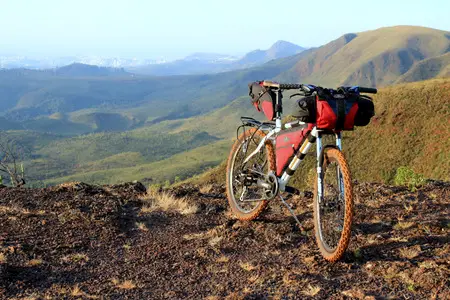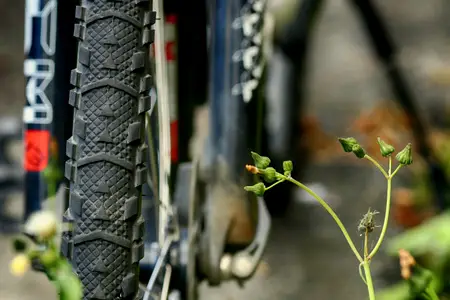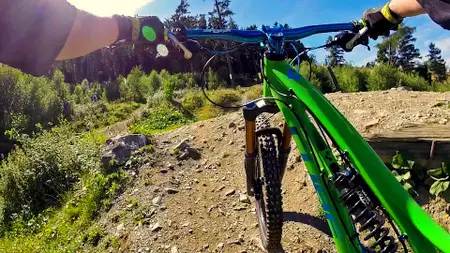What is Bikepacking?
If you’re an outdoor enthusiast but find hiking just a little too slow paced for your liking, you might want to give bikepacking a go. Also known as mixed terrain cycle touring, bikepacking isn’t your average ride through a city or along well-groomed bike paths. Bikepacking is designed for cyclists who are looking to get well and truly off the beaten path, where you can expect to ride on a variety of surfaces and topography.
While bikepacking has been around for over a hundred years, it’s just now really starting to gain traction with adventure seekers around the world. You don’t need to be a professional cyclist to experience bikepacking, but there are a number of tips and tricks you need to be aware of in order to ensure your safety. You should also familiarize yourself with the appropriate type of bikes and gear that’s needed for a bikepacking adventure.
Because bikepacking often means tackling rough terrain in remote regions of the world, knowing how to do it properly is key. Strap on your helmet and get into gear as we get the wheels turning on how you can experience bikepacking for yourself.


What Exactly is Bikepacking?
You know you’re in for a crazy bike riding adventure when bikepacking is referred to as “rough riding” by Americans and “rough stuff” by Europeans. Many people enjoy the freedom bikepacking brings and often provides an excuse to get out in nature to enjoy some personal time alone. For some, it can almost be a spiritual experience and definitely isn’t bad for your health and fitness either. Others have taken off-road biking to the next level by competing in racing events like cyclo-cross, mountain bike racing, or cross-country cycling events.
Bikepacking combines all the thrills of backcountry backpacking with the more adrenaline pumping action of mountain biking. It’s about leaving the pavement to tackle roads made of dirt, mud, sand, and rocks. Almost anyone with an avid sense of adventure can enjoy bikepacking and it doesn’t have to cost you a lot of money. That being said, it’s wise to invest in some quality equipment and travel to bikepacking routes that have proven to be epic.
Whether you are planning an overnight, weekend, or multi-week bikepacking adventure, you’ll need some advice on what bike to chose, what gear to pack, and which routes to take. The goal is to pack everything you may need while still maintaining a minimalist approach to camping since you will need to carry everything with you while riding.
Bikepacking Routes & Riding Tips
A lot of thought and planning should go into choosing a route for your bikepacking adventure. Thankfully, planning is often one of the most fun aspects of the adventure as it amps you up for your trip. There are countless bikepacking routes available all over the world across six continents. Adventures range from basic overnight journeys to multi week and even month long adventures. You can choose your own route or one that’s been tried and tested before.
The legends over at Bikepacking.com have created an excellent database of bikepacking routes from all over the world. They provide detailed information and reviews on all kinds of different bikepacking routes and offer a great collection of tips, tricks, guides, and reviews on the latest bikes and gear.
While some of the most legendary bikepacking routes may be remote and take a bit of effort to reach, others may be right in your own backyard. Routes can be found in state parks, national parks, and wilderness areas in most countries. One of the most important aspects when it comes to choosing a route is to select one that matches your skill level. You also want to make sure you’ll have access to potable water or at least have the ability to treat water from wild sources. You will need to arrange where you will sleep each night, whether that means booking a campsite or planning your route to end at locations that offer lodging each night.
Epic Routes
There are way too many incredible bikepacking routes available to mention all of them but the following are some notable ones you may wish to tackle.
New Zealand offers up The Old Ghost Road, the country’s longest single track ride. Accessible for intermediate mountain bikers, the ride takes in some of New Zealand’s most stunning landscapes including natural features like waterfalls, mountains, and fern-filled forests.
Scotland has The Highland Trail which will have you riding through roughly 550 miles of remote Scottish Highlands terrain. This is a serious ride where you may even need to tackle sections on foot while carrying your bike where the trail becomes to rugged.
You’ll find an even more spiritual bikepacking route with Israel’s Holyland Challenge which crosses the country from Mt. Hermon to the Red Sea city of Eilat.
American’s need not travel abroad to experience some quality rides, as a number of states provide some incredible routes. Those looking for a serious challenge can try the Colorado Trail through the Rocky Mountains during the summer or Arizona’s Black Canyon Trail during the cooler winter months. Experience “The Other Side of Nowhere” by checking out the 3-day bikepacking loop offered in Texas’s Big Bend Ranch State Park.
Riding Tips
- Ride using an easier gear to limit fatigue
- Don’t ride as fast as you normally would, as rough terrain may require slower speeds and longer stopping distances
- Travelling with packs and gear means you may want to add extra air to your tires and air-sprung suspension
- Make sure to have your bike checked for mechanical issues before your trip
- Be sure to pack plenty of water, a water-purifying kit, and enough food
- Ride with a buddy or inform someone of your itinerary
- Carry maps and a GPS
- Don’t overpack as this will make riding cumbersome and decrease your enjoyment
Recommended Bikes for Bikepacking
There is no single set model or style of bike that’s recommended for bikepacking, but you should choose one that can handle the conditions and terrain you expect to experience. If you’re just starting out bikepacking, you can simply use your off-road mountain bike or gravel bike you currently have. The main thing you want to make sure of is that you can easily attach packs to your bike. You may have to modify your current bike by purchasing a front or rear rack system.
You want to make sure your bike is comfortable to ride for long durations, as many bikepacking routes are multi-day adventures. Your bike should fit you properly and allow you to maintain good posture. You of course want a bike with a comfortable seat and all mechanics of the bike should be in good working order. If you plan on purchasing a new bike specifically suited for your bikepacking adventure, be sure to break it in by riding it several times before your actual trip to work out any issues.
Bikes that have been specifically designed for bikepacking will offer you the most comfort and best overall riding experience. Common bike styles that are often used for bikepacking include all-road bikes, cross country hardtail bikes, fully rigid bikes, plus tire bikes, full-suspension bikes, and fat bikes. Which one you choose will depend on which type of adventures you plan on experiencing most.


Recommended Gear for Bikepacking
What and how much you pack will largely depend on how long your bikepacking adventure will be. You never want to pack too much, but you definitely don’t want to be stranded somewhere remote without the tools to keep you alive and well.
Generally speaking, you should pack much the same as you would for a backcountry backpacking trip. This means packing a tent, sleeping bag, cooking equipment, water purification system or tablets, GPS, appropriate apparel, fire making kit, and a first-aid kit. The only main difference with a bikepacking adventure is you should really focus on lightweight alternatives for items and carry extra items that may be needed for your bike.
You need to remember that food is fuel and you’re going to need a lot of it due to the fact you will be using a lot of energy each day. Always carry more food than you’ll think you need and the right types of food that will give you the most energy and nutrients without weighing your packs down. Water is of course essential and you may be able to carry enough bottled water with you for short journeys. Longer journeys will require fresh drinking water sources throughout the route or require you to have some way of purifying water. Don’t forget to pack environmentally friendly toilet paper, because nature definitely still calls while you’re actually in nature.
In addition to keeping yourself healthy, you want to pack a bike repair kit should your bike experience any hardship. Your kit should include things like spare tire inner tubes, tire-repair kit, multi tool with chain tool, bike lock, chain lube, chain pins/power links, tarp to cover your bike in inclement weather, and spare cables. You may also want to pack a handlebar light if you plan on riding in the dark.
When it comes to apparel, be sure you dress for any elements you may face. Sturdy waterproof hiking shoes are a must, especially when it becomes too difficult to ride and you must walk, rain jacket, padded bike shorts, bike gloves, pair of casual shoes for around camp, and warm clothes for night time. The tip to remember is you want to be cool while riding and warm whenever you stop.


How to Pack for Bikepacking
There are many ways to pack your bike for a bikepacking trip and a number of different bag styles you can choose from. Whichever bags you choose and no matter how you pack, you want to be sure to pack light and keep the overall weight of your packs balanced on your bike while riding.
Your setup will most likely consist of a combination of pack styles. While you can wear a lightweight backpack or hydration pack such as a Camelback, you generally want to stick with packing bags that will attach to your bike. This will avoid you becoming fatigued or sore while riding.
Bike cargo pack styles include panniers that attach to front or rear racks, saddle bags, frame bags, handlebar bags, and top tube bags. Research what packs are right for you and the adventure you are planning on taking. You can be assured there are numerous pack options that will fit your style of bike.
Just use common sense when choosing bags, for instance opting for long slender bags as opposed to short fat bags for handlebar bags. And in case bag straps break or fail in some way, pack some zip ties, bungees, and carabiners to come to the rescue.
We hope we have encouraged you to give bikepacking a go, or provided you with helpful tips if you are already a bikepacker. We wish you safe travels and hope to see you out on the trails soon.












October 31, 2019
Mindblowing writing! After reading this article, now thinking Bikepacking is not so difficult. Its a complete guideline for Bikepacking, So, no chance to mistake anything else. I appreciate your experienced presentation.
November 2, 2019
I never went to bikepacking, maybe its the first time I am hearing the words, but to be honest it looks perfect, I would definitely give it a try 🙂
December 2, 2019
You know you are for crazy bike rides when the bicycle is preferred to as “American rides” and “rough” by the Europeans. Most people enjoy the freedom of the bike when bring and always provide the opportunity to get out of nature to enjoy the freedom of the bike we bring and always provide the opportunity to get out of nature to enjoy some personal time alone. For some, it can almost be a spiritual experience and of course not bad for your health and exercise either. Others have taken bicycle rides on the road to the next level by competing in sporting events like cycle-cross, bicycle racing, or national cycling events.